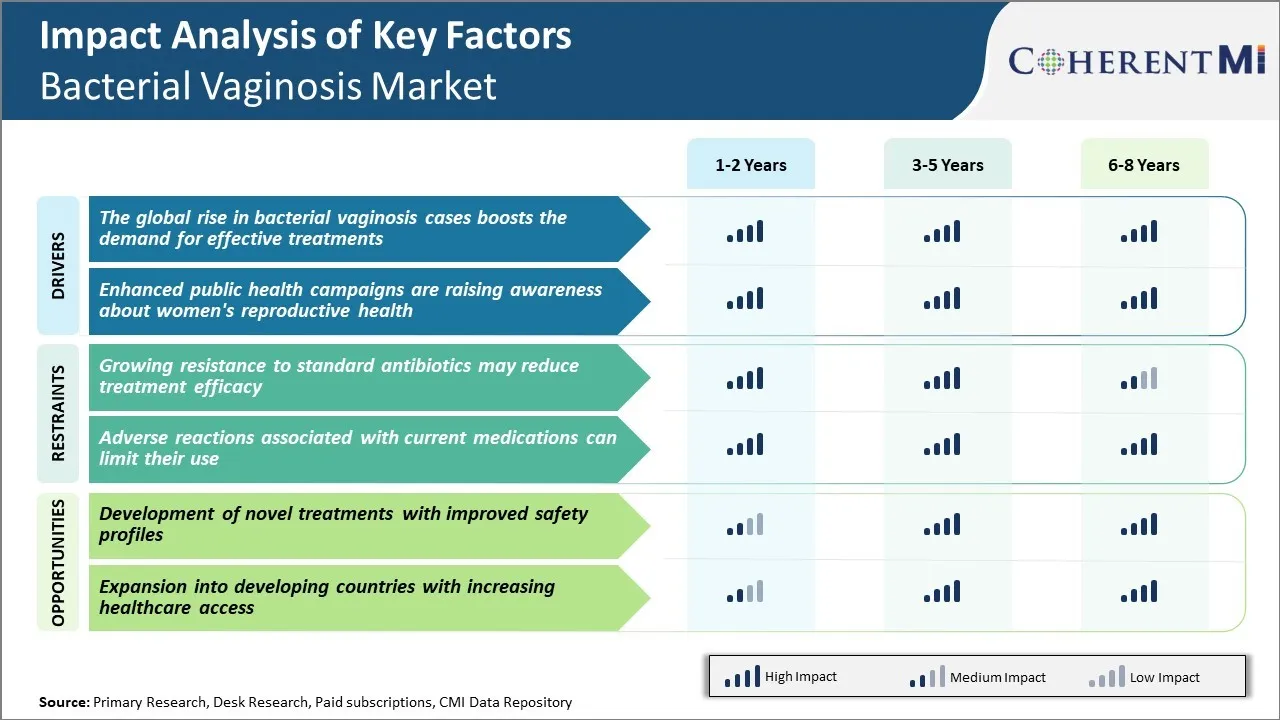Bacterial Vaginosis Market Trends
Market Driver - Global Rise in Bacterial Vaginosis Cases Boosts the Demand for Effective Treatments
Bacterial vaginosis or BV is one of the most common causes of vaginal infections amongst women. As per our research, over the last few years the worldwide prevalence of BV cases has shown a notable rise. BV often causes unpleasant symptoms such as abnormal vaginal discharge and fishy odor which impacts the quality of life and well-being of affected women. This has led to a growing demand for effective therapies that can alleviate discomfort faster and cure the infection completely.
Pharmaceutical companies engaged in developing treatment options for BV have reported sizable gains as more patients now opt for medication rather than ignoring the problem or relying only on over-the-counter remedies which often provide temporary relief. Prescription drugs containing antibacterial and anti-inflammatory agents are preferred for their targeted approach at getting rid of the causative bacteria and prevention of recurrence once the course is complete.
The rising global disease prevalence consequently spurs the total market demand for reliable BV therapies. Pharma firms actively work on new drug formulations, combination therapies and diagnostic tools to address unmet needs and expand their market share. Overall modern medicine appears to be benefitting the most from this upward trend in infections caused by bacterial vaginosis worldwide.
Market Driver - Enhanced Public Health Campaigns are Raising Awareness About Women's Reproductive Health
In recent times, with improving education levels and growing openness in society, conversations around women's reproductive health issues have become less taboo. Various non-profit organizations and public entities have launched extensive awareness programs through different mediums to educate women about common gynecological infections like bacterial vaginosis or BV and the importance of timely diagnosis and treatment.
These campaigns highlight how frequent vaginal infections can disrupt the natural pH balance in the genital tract making women more susceptible to contracting sexually transmitted diseases. They emphasize that BV, though a mild condition by itself should not be ignored, as it could potentially enable opportunistic infections to take hold.
Several television, radio and digital advertisements present candid yet sensible messaging on signs and symptoms of abnormalities that warrant medical review. While being mindful not to cause unnecessary worry or dispel misinformation, they motivate women to respect their bodies and take informed healthcare decisions without facing social stigma.
A result of these sustained drives has been a surge in health-seeking behavior. More women now visit general physicians or gynecologists on noticing any unusual vaginal discharge. Overall, such cultivation of knowledge aids both individual well-being and public health by curbing complications at mass scale.

Market Challenge - Growing Resistance to Standard Antibiotics may Reduce Treatment Efficacy
One of the major challenges facing the bacterial vaginosis market is the growing resistance to standard antibiotic treatments being used currently. Bacterial vaginosis is commonly treated with antibiotics like metronidazole and clindamycin.
However, studies show that there is emerging resistance to these first-line treatment options. Resistance to metronidazole, the most commonly prescribed antibiotic for BV, has been reported to range between 15-40% globally. Similarly, resistance to other standard antibiotics is also on the rise. This poses a significant threat as it can reduce the efficacy of current treatment regimens and make BV increasingly difficult to treat.
With limited treatment options available, antibiotic resistance can potentially worsen patient outcomes and may lead to more frequent relapses or recurrent infections. It could also drive-up healthcare costs if patients need longer or more complex or expensive therapy options. This growing resistance further highlights the need for novel treatment alternatives with new mechanisms of action to circumvent emerging resistance issues and provide more effective solutions for BV management over the long term.
Market Opportunity - Development of Novel Treatments with Improved Safety Profiles
One of the major opportunities in the bacterial vaginosis market is the development of novel treatment options that have improved safety profiles over standard antibiotic therapies. Current first-line treatments like metronidazole and clindamycin are often associated with side effects like nausea, vomiting and diarrhea which can affect patient compliance.
Also, recent studies have indicated potential long-term side effects with prolonged antibiotic usage including increased risks of antibiotic resistance, allergy and opportunistic infections. This presents a large unmet need for safer and better-tolerated non-antibiotic treatment alternatives.
Novel drug formulations, new drug classes, probiotics or microbiome-based therapies can potentially address this need by providing safer options for BV with kinder profiles and potentially improved efficacy too. Their successful development and commercialization will capture a significant share of the market as they address the tolerability limitations of existing standard of care antibiotics greatly enhancing the patient experience and clinical outcomes for bacterial vaginosis treatment.